Key takeaways:
- Drone mapping enhances the understanding of landscapes and supports fields like agriculture and conservation by providing detailed ecological insights.
- Storytelling techniques enrich mapping projects by adding emotional depth and personal narratives, transforming data into relatable experiences.
- Integrating human experiences with geographical data creates a compelling narrative that fosters empathy and encourages action towards environmental conservation.
- Effective strategies include emotional connections, multimedia elements, and interactive maps to engage audiences and deepen their understanding.
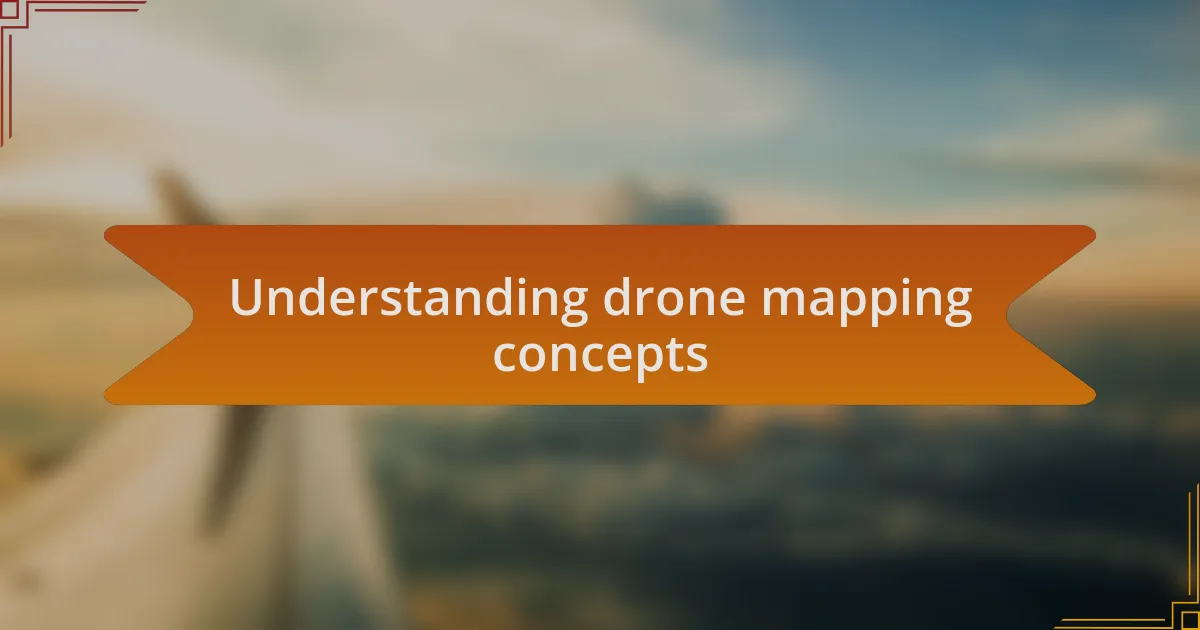
Understanding drone mapping concepts
When I first delved into the world of drone mapping, I was amazed by how aerial imagery transforms the way we visualize landscapes. Imagine seeing the intricate patterns of the land from above—it’s like revealing a whole new layer of information about our environment. This perspective not only enhances our understanding but can also evoke a sense of wonder about the natural world.
Understanding drone mapping concepts means grasping the technology behind it as well. Drones capture high-resolution images, which are then processed into detailed maps. Think about trying to piece together a jigsaw puzzle without seeing the whole picture; that’s what mapping feels like until each piece falls into place.
One exciting aspect of drone mapping is its applications in fields like agriculture and conservation. For instance, I remember a drone mapping project aimed at assessing coral health around Zanzibar. It was thrilling to see how mapping not only documented the area’s beauty but also painted a clearer picture of its ecological challenges. Can you see how vital these insights are for preservation efforts?
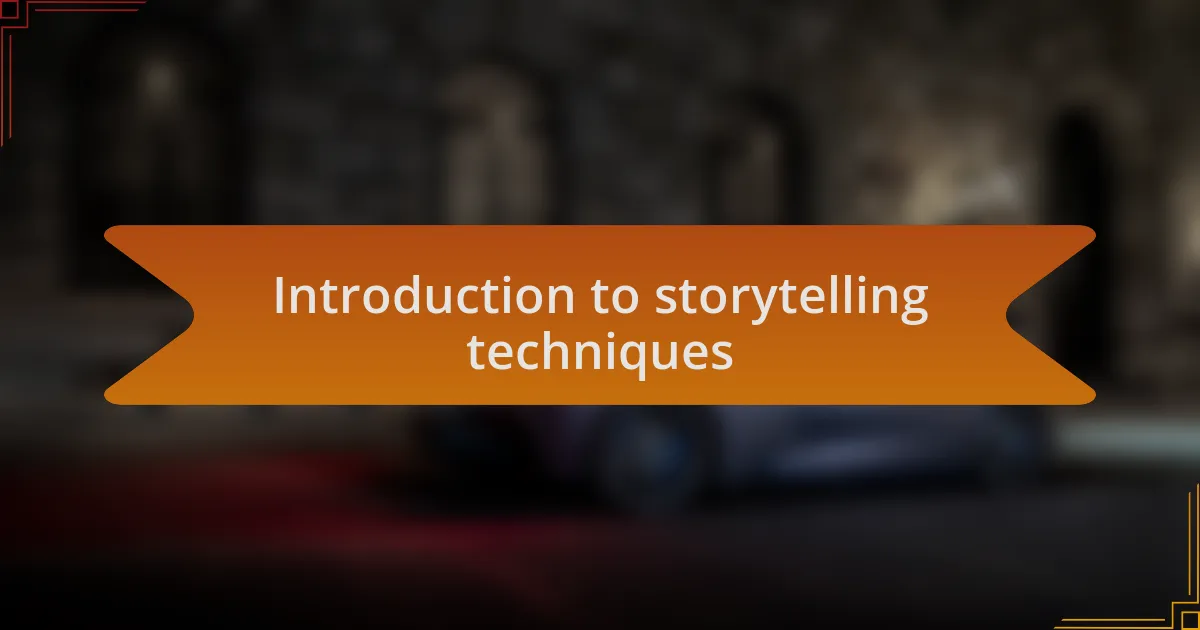
Introduction to storytelling techniques
Storytelling techniques play a pivotal role in how we connect with our audiences, especially in a visually driven field like drone mapping. One compelling approach is to create a narrative arc that encapsulates the journey of the mapping process. For instance, I often think about how sharing stories about the places each drone captures can transform mere data into a vibrant tale of discovery and exploration.
I remember presenting a mapping project in Zanzibar, and instead of just showcasing the maps, I shared the stories of the locals who depend on those landscapes. Their voices added depth and personality to the visuals, reminding us that behind every pixel lies a human experience. Isn’t it fascinating how storytelling can breathe life into the data we gather?
Another effective technique is to build suspense and invoke emotion. When mapping areas at risk, I often emphasize the urgency of conservation, framing each drone flight as a quest to uncover hidden truths. I find that this approach not only captivates the audience but also inspires action. Doesn’t it make you think about the responsibility we have to share these stories and drive positive change?
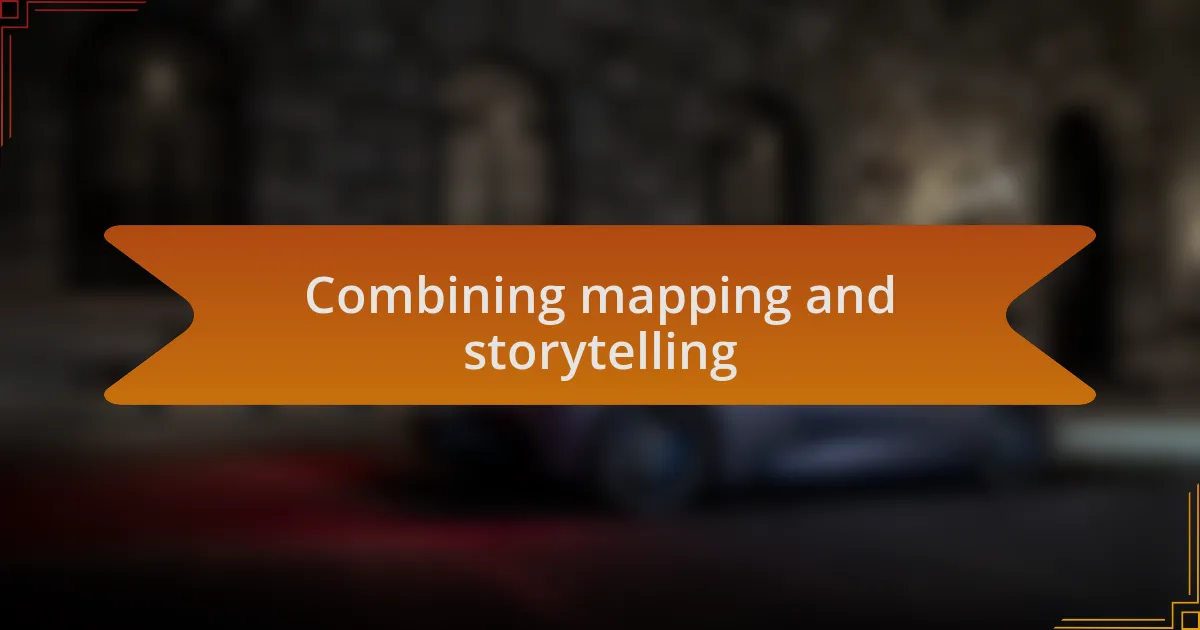
Combining mapping and storytelling
When I think about integrating mapping with storytelling, the art of weaving personal experiences into geographical data becomes apparent. For example, during a drone mapping session over Zanzibar’s stunning coastline, I didn’t just collect images; I immersed myself in the vibrant culture surrounding those areas. The stories of fishermen bringing in their daily catch or children playing on the beach became part of the narrative. Isn’t it amazing how these stories can transform a simple map into a richer tapestry of life?
One of my favorite memories involves capturing a drone image right before a local festival. As the drone soared over the festivities, I realized that the colors and movements below told a story of unity and joy. Each frame I captured wasn’t just a data point; it was a frozen moment in time that conveyed the heartbeat of the community. How often do we overlook the emotional resonance that accompanies the places we explore? By sharing these insights, I’ve found that audiences connect on a deeper level, eager to know more about the cultures within the landscapes.
Moreover, incorporating storytelling elements can reshape how we perceive the challenges faced by different regions. When mapping environmentally sensitive areas in Zanzibar, I often recount tales of resilience from local conservationists who are fighting against the odds. These narratives not only emphasize the importance of protecting these landscapes but also invite the audience to become part of the solution. What if we could inspire others to take action just by sharing these powerful stories? It’s this combination of mapping and storytelling that creates a profound impact, prompting reflection and encouraging change.
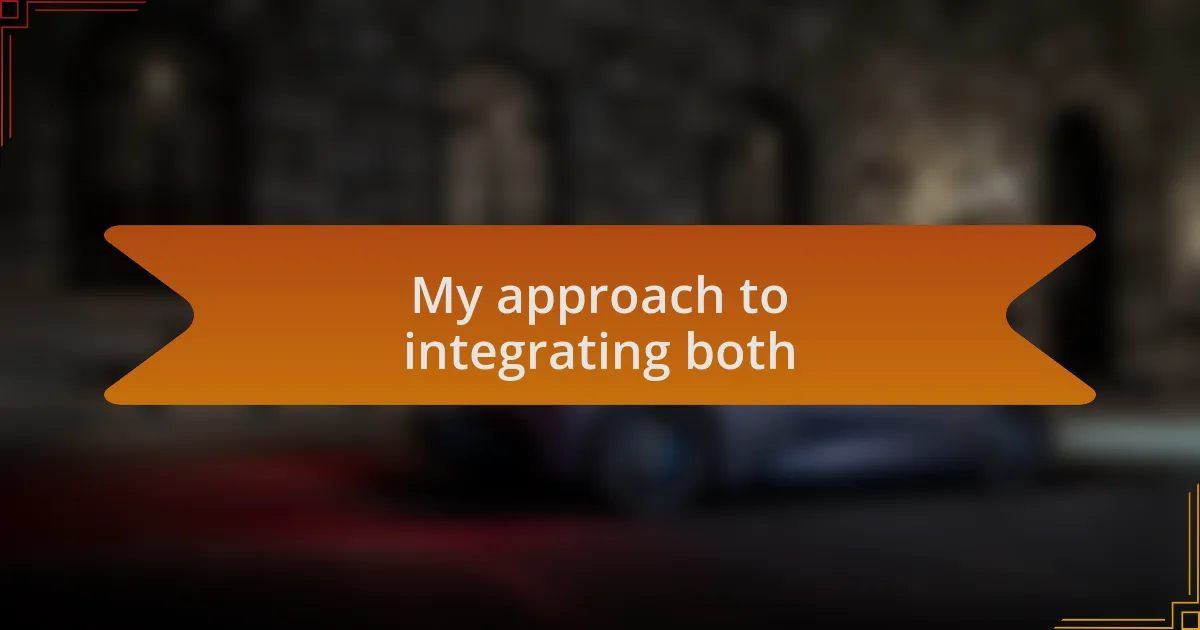
My approach to integrating both
My approach to integrating mapping with storytelling starts with a simple yet profound realization: every map has a heart. I remember one afternoon flying my drone over the lush greenery of a local village. As I captured the sweeping landscapes, a group of children waved from the fields, their laughter echoing in the warm breeze. It struck me that this moment was a link between the geography and the human experience, showcasing not just the land but the joy of its inhabitants.
I often find that layering narratives onto maps can enhance the viewer’s journey. For instance, while mapping the ecotourism potential in Zanzibar, I shared stories of travelers who discovered hidden treasures, like secluded beaches and local artisans. This approach invites people to envision their adventure, sparking curiosity rather than merely presenting data. Can you imagine feeling the excitement of exploration as you follow a map dotted not just with locations but with personal experiences?
In my process, I strive to encourage the audience to engage with the content on a deeper level. When I present maps that illustrate community dynamics, I weave in narratives that highlight local challenges and triumphs. For example, I recall discussing the impact of climate change with a fisherman who taught me the significance of sustainable practices. By sharing his story, I aim to foster empathy and understanding, prompting each viewer to reflect: how can we all play a role in preserving these stories and landscapes for future generations?
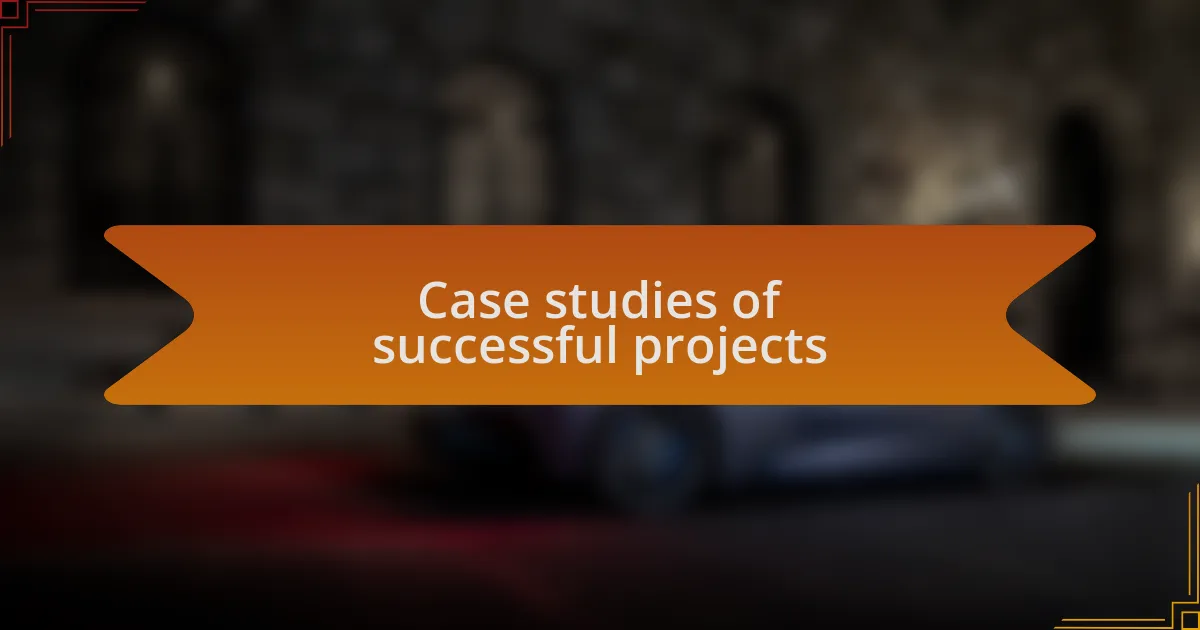
Case studies of successful projects
One striking project involved mapping the location of historical sites in Stone Town. As I navigated my drone through the narrow streets, I stumbled upon a forgotten courtyard where locals gathered for evening prayers. Sharing the story of this serene gathering alongside the map illuminated the cultural significance of the space, prompting visitors to consider not just where to go but the rich narratives that breathe life into these locations. Have you ever thought about how a simple mapping project can unveil layers of history?
Additionally, during a recent initiative aimed at improving local agriculture, I captured aerial views of farming practices while also documenting the stories of the farmers themselves. One farmer shared how adopting sustainable techniques transformed his family’s livelihood, leading to greater food security. Integrating his narrative with the drone imagery made the map a powerful tool for education, inspiring others to see farming as not just a profession but a means to enhance community resilience. It left me pondering: how many more stories lie beneath the surface of our landscapes, waiting to be told?
Finally, I worked on a project mapping the coral reefs around Zanzibar, carefully documenting their decline and the tireless efforts of local conservationists. While flying overhead, I met a passionate marine biologist who shared his vision for restoring these vital ecosystems. By pairing his insights with the stunning visuals of the reefs, the map became a call to action, urging viewers to understand their role in the preservation of these wonders. Isn’t it remarkable how a well-crafted narrative can compel us to take action, making us feel more connected to the cause?
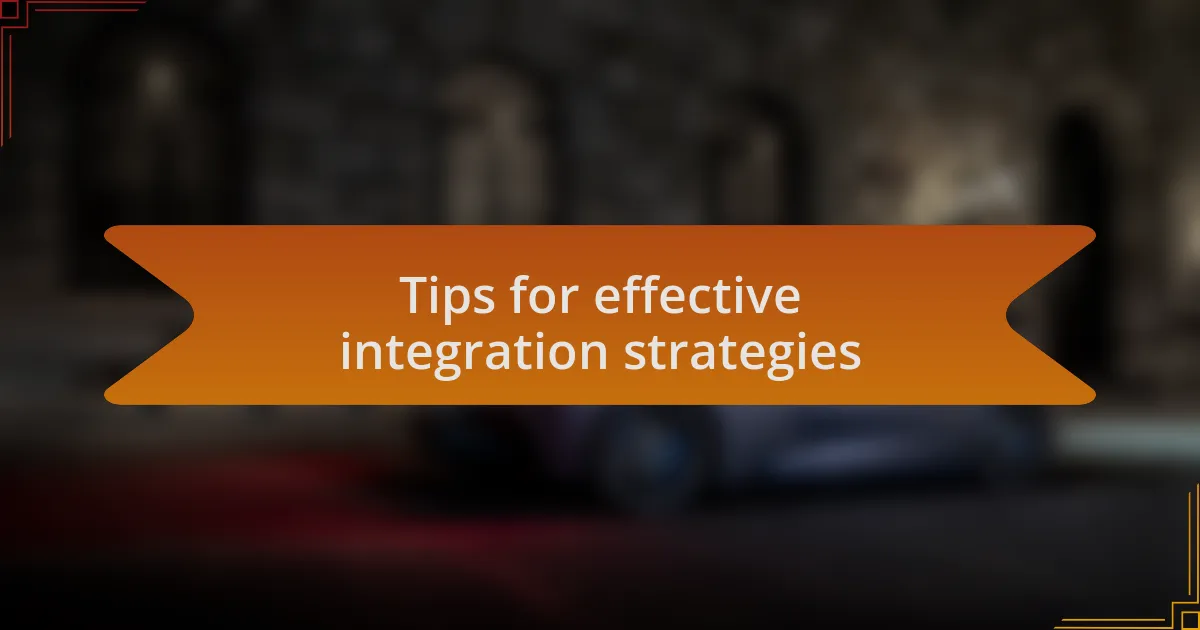
Tips for effective integration strategies
When integrating mapping with storytelling, focus on making emotional connections. I remember a time when I included personal testimonials from community members affected by environmental changes in Zanzibar. Sharing their heartfelt struggles and triumphs alongside the mapped data not only humanized the statistics but also drew in my audience. Have you ever felt more compelled to act after seeing someone’s real-life story?
Another effective strategy is to use multimedia elements, such as videos or audio clips, alongside your maps. I once incorporated short clips of local guides explaining the significance of certain areas while flying over them. This combination of visuals and narratives sparked curiosity and allowed viewers to experience a deeper understanding of their surroundings. Don’t you think combining different formats can transform how we perceive information?
Finally, think about the presentation of your maps. I learned that an interactive approach can make a huge difference. On one occasion, I created a dynamic map where users could click on various locations to reveal stories and photos. This engagement not only made the experience enjoyable but also encouraged users to explore more actively. Isn’t it fascinating how interaction can turn passive viewers into enthusiastic participants?